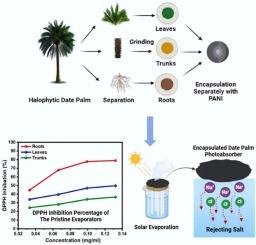利用太阳能蒸汽发电,回收盐生椰枣废料装饰聚苯胺高效抗盐
IF 6
2区 工程技术
Q2 ENERGY & FUELS
引用次数: 0
摘要
为了实现太阳能蒸汽发电(SSG)的最佳性能,高效的光热转换过程是必不可少的,这是一种提供可持续供水的有前途的方法。在这种情况下,盐生植物,能够在高盐度环境中茁壮成长的耐盐植物,被用作拒盐吸收剂。以盐生植物残体叶片、树干和根为研究对象,对其抗高盐能力进行了评价。在不加任何修饰的情况下,根渣蒸发速率为1.15 kg m−2 h−1,转化效率为79.01%。此外,植物残留物被聚苯胺包封,这是一种很有前途的光热材料,其蒸发速率为1.89 kg m−2 h−1,Roots@PANI的转化效率为97.7%。2,2-二苯基-1-苦味酰肼(DPPH)自由基抑制活性测定表明,对树干、叶片和根的抑制率分别为36.85%、49.96%和79.09%。这表明,棕榈根系中总抗氧化剂含量高于其他部位,具有较强的抗盐能力。因此,我们的系统被认为是一种生态友好的方法,可以减少海水淡化过程对环境的影响,并通过利用太阳能和废物回收来降低水的生产成本。本文章由计算机程序翻译,如有差异,请以英文原文为准。

Recycling of halophytic date palm wastes decorated polyaniline for highly efficient salt resistance through solar steam generation
To achieve optimal performance in solar steam generation (SSG), a promising approach for delivering a sustainable water supply, an efficient photothermal conversion process is essential. In this context, halophytes, salt-tolerant plants capable of thriving in high-salinity environments, are employed as salt-rejecting absorbers. Three different parts of halophyte plant residues, leaves, trunks, and roots, were studied to evaluate their ability to resist high salinity. An evaporation rate of 1.15 kg m−2 h−1 with a conversion efficiency of 79.01 % was achieved using root residues without any modification. Furthermore, the plant residues were encapsulated in polyaniline, a promising photothermal material, resulting in an outstanding evaporation rate of 1.89 kg m−2 h−1 and a conversion efficiency of 97.7 % for Roots@PANI. According to 2,2-diphenyl-1-picrylhydrazyl (DPPH) radical inhibition activity measurements, the inhibition increased to 36.85 %, 49.96 %, and 79.09 % for trunks, leaves, and roots, respectively. This suggests that palm tree roots contain a higher total antioxidant content than the other parts, providing a stronger defense mechanism against salinity stress. Accordingly, our system is considered an eco-friendly approach that reduces the environmental impact of desalination processes and can lower water production costs through solar energy utilization and waste recycling.
求助全文
通过发布文献求助,成功后即可免费获取论文全文。
去求助
来源期刊

Solar Energy
工程技术-能源与燃料
CiteScore
13.90
自引率
9.00%
发文量
0
审稿时长
47 days
期刊介绍:
Solar Energy welcomes manuscripts presenting information not previously published in journals on any aspect of solar energy research, development, application, measurement or policy. The term "solar energy" in this context includes the indirect uses such as wind energy and biomass
 求助内容:
求助内容: 应助结果提醒方式:
应助结果提醒方式:


